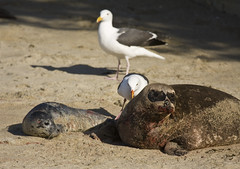
Sunshine, salt air, the bark of seals and... fossils await for those lucky enough to beach comb the fossiliferous shores near the fishing community of Sooke on Vancouver Islands' southwestern edge.
Sooke was originally inhabited by the T'sou-ke, a group related to the Salishan First Nations, who found the mild climate and sea access ideal. A fossil field trip brought me there last summer to explore the tidepools and well preserved marine fossils near the seaside exposures at Muir Creek.
Along the beachfront, you can find blocks of late Oligocene, 20-25 million year old, sandstone full of small gastropods, bivalves and barnacle bits of the Sooke Formation. By the late Oligocene ocean temperatures had cooled to near modern levels and the taxa preserved as fossils bear a strong resemblance to those found living beneath the Strait of Juan de Fuca today.

Mammal material, echinoids, coral, chitin and limpets are also found here but are rare. In this photo, you can see a group of happy avocational paleontologists carrying a heavy whale skull.
The largely intertidal assemblage of fossil species, many of which will look familiar as you've seen their modern rellies, tell us that the formation was layed down near shore. The thickly strewn layers you'll see as big fossiliferous blocks and the lines of fossils you'll notice in the nearby cliffs suggest that they may have been deposited along a strand line. What you're sure to notice is the great ocean view and how easy it is to find something spectacular. Whether you make a day of it or just a twenty minute luxurious beach stroll, your pockets will be filled with a healthy serving of ancient clam stew!





Comments